この本はとても面白いです!私は犬が大好きです。日本の文化と歴史があります。いい本です。
The story is very interesting and tells about a historical event and why a famous statue was built in front of 渋谷駅. I learned a lot from the book (both new words and Japanese culture).
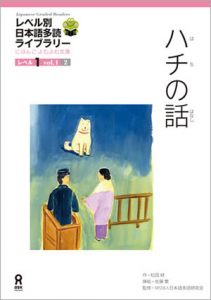
Smith College Tadoku Project
この本はとても面白いです!私は犬が大好きです。日本の文化と歴史があります。いい本です。
The story is very interesting and tells about a historical event and why a famous statue was built in front of 渋谷駅. I learned a lot from the book (both new words and Japanese culture).

私は本のプッロトは優しくて面白いと思います。この本はむずかしたんごと漢字がありません。綺麗なピクチャーがたくさんあります。いい本です!
I recommend the book to JPN110 students. The plot is pretty easy and interesting, and there are no difficult words and sentences. I like the pictures and the story a lot. The turning at the end is good.
わたしはきょうおの本を読みました。この本にたくさんカタカナがありますから、ちょっとむずかしいです。でも、plotはおもしろいですね。わたしはカタカナをよむのが下手です、よむのがとてもたいへんです。。。
I read this book for around 5 mins. I chose this book basically because I wanna practice my katakana reading skill. However, I feel a little bit frustrated when I read this book for a while. It’s really hard for me to understand messages from the book. But it’s kind of interesting in form of texting messages in friend groups.
この本は日本の文化を話します。日本人は結婚式に行って、お金を持ってきます。中国人もお金を持ってきます。面白いですね!でも、かんじはちょっと難しです。でも、きれいなえがあります。かんじをわかると思いました。
I think this book is interesting in that it talks about Japanese culture. In both China and Japan, people would bring money to marriage ceremonies. However, there are a lot of Kanjis in this book. The fact that I’m a Chinese speaker and there are pictures helps me in understanding it. However, I would only recommend this book to higher-level Japanese learners and 100-level learners who had previous exposure to Kanji
s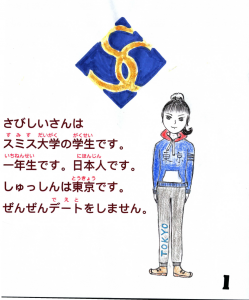
この本は私のたもだちのメイバルさんの本です! としょかんでメイバルさんといっしょにべんきょうして、日本語のクラスに思って、この本をを見ました。
寂しいさんはスミス大学の学生です。ぜんぜんデートをしません。日本語のクラスのあとに、散歩します。メアリーさんとスーさんにあって、この二人でデートをしています。かわいと思いますが、寂しさんは寂しいです。そして、パーティーにぜんぜん行きません。寂しさんはとても寂しいですね!
メイバルさんは二年生の時、この本を書きました。今、四年生です。でも、二人(私とメイバルさん)で彼氏がありません!残念です!
This book was created by my friend Mabel! We were doing homework in the library together. I was reading one of the Yomu Yomu books and Mabel asked me what I was doing. Then we started to read her book together.
I would definitely recommend this book to first-year Japanese learners, especially to introverted students at Smith College. Mabel and Ray used vocabulary that we’ve learned, and I find it pretty easy to read. The story itself is also simple and interesting.
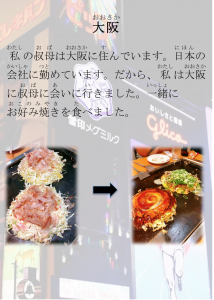
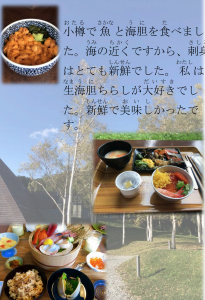
私この本は大好きいです!この人は北海道と東京と大阪と京都に行って、たくさんすごくきれいなしゃしんをとりました。たくさん食べ物のしゃしんがあります。例えば、すし、うなぎ、魚、うに、ももの飲みものともものアイスクリームがあります。私は食べ物が大好きですから。この本をよんて、日本に食べものを食べにいくと思いました。よる、この本を読まないと思いました。
I really like this book and would recommend it to first-year Japanese learners. The author uses vocabulary that we learned, as well as some new vocabulary in describing food and tourist attractions. They also use grammar structures that we’ve just learned!
The author wrote about her traveling in Japan. She visited Hokkaido, Tokyo, Osaka, and Kyoto. She took a lot of beautiful pictures, and most of those pictures are food. While the pictures make me really want to visit Japan and try Japanese food, I would not recommend people reading it at night like I did, because the food simply looks too good.
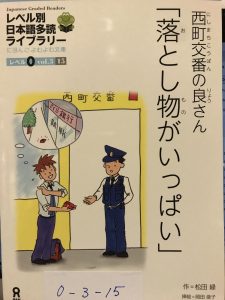
この本はかわいいですね。とりとねこがいます。本はおもしろくて、たのしくて、にぎやかです。しゃしんはいいですよ。やさしい本を読むと思います。
I would recommend this book to my classmates. It helped me practice directions because in the book it explains where these lost items or pets were found. It was also fun to read because of the drawings conveyed the emotions behind each incident well.
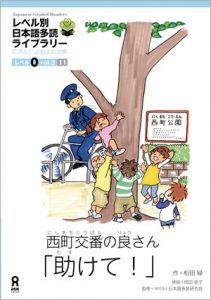
この本はとてもおもしろいです。良さんはおまわりです。よくみんなさんはてつたいます。
I recommend this book. It is a story about a policeman in a town. The policeman often help a lot of residents to solve their problems. However, he himself once met a problem and needed help. It is a very interesting story. It also contains a lot vocabularies that we have learned in the previous eight units. Moreover, it contains some new words that we have not yet learned. But it is still not hard to understand, because there are many cute and nice images that can help us understand the content.
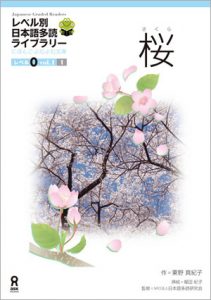
これはおもしろい本でした。私(わたし)は子(こ)どもの時(とき)Washington DCで桜(さくら)を毎(まい)ねん見(み)ましたから。日本(にほん)のちいきがたくさんあります。ちがうのちいきで桜がちがうの時間(じかん)にさきます。
I would recommend this book to students who are finishing their first semester of Japanese. Reading this book is a good way to practice many of the kanji we learned. It was also interesting to learn about the regions of Japan and how that affects the cherry blossom trees. The illustrations were very pretty, so the book was fun to read.
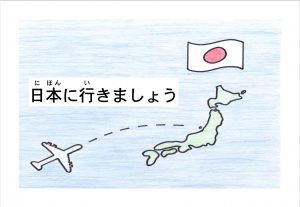
この
I would highly recommend this book to other Japanese 110-111 students because it uses grammar that they would know, and it also uses kanji that they should have already learned. The drawings are very simple, neat, and nice to look at. I definitely like the use of simple phrases like いただきます as well.に